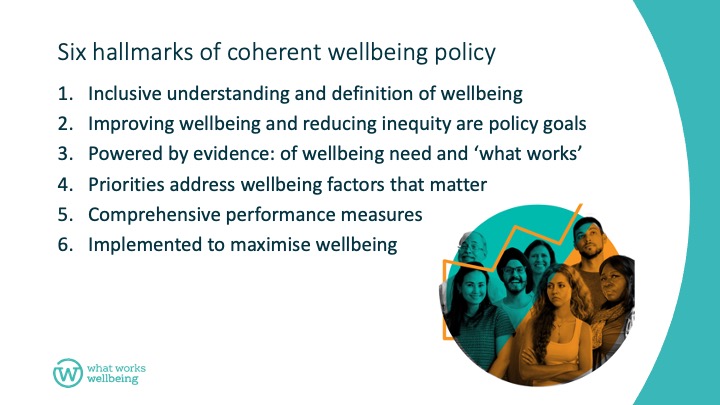Local area action plans: learning from wellbeing research and practice
Head of Implementation and Learning, Joanne Smithson, has led a three-year project funded by The Health Foundation to strengthen the wellbeing impact of local government policy making in the UK.
The work draws on Joanne’s public health knowledge and senior local government policy experience. Here, we reflect on the research and the implementation cohort, and their outcomes.
At What Works Centre for Wellbeing, we’re interested in understanding not only what works, but also how we can apply findings in practice.
Making wellbeing a central goal of UK policy
The project is a response to Professor Sir Michael Marmot’s challenge:
“…this report is calling for a reordering of national priorities. Making wellbeing rather than straightforward economic performance the central goal of policy will create a better society with better health and greater health equity.” – The Marmot Review ten years on, p.150 (Marmot et. al. 2020)
To do this, we need to know how to do this in practice at individual, local and national levels. This is why we set out to identify and support local authority mechanisms.
The project considered three research questions:
- Is it possible to identify hallmarks of health and wellbeing strategies that maximise wellbeing?
- What are policy professionals’ experiences of successfully developing a wellbeing approach in local government?
- What does wellbeing policy making look like in action?
Part 1: Six hallmarks of coherent wellbeing policy
To explore what makes a coherent policy, and how it can be developed, we conducted a qualitative thematic content analysis of a random sample of 26 upper tier English Local Authority health and wellbeing strategies.
We also interviewed seven policy professionals who have successfully developed a wellbeing approach in local government in England. A strengths-based Appreciative Inquiry framing was used throughout to support future knowledge translation. This involves identifying what is working well, analysing why it is working well, and then doing more of it.
We have been able to identify six hallmarks of coherent wellbeing policies:

Based on the six hallmarks, and using learning from published English Health & Wellbeing Strategies, we have developed a maturity model for wellbeing policy makers. It details three increasingly mature levels of policy making: assuring, optimising and maximising, to support users to self-assess and benchmark their work. Users can find where they are situated and identify opportunities for improvement.
The tool was refined during discussions and testing with local authority, public health and policy professionals in the UK, Canada and worldwide.
Part 2: Establishing a learning community
To gain a better understanding of wellbeing policy making in action, we built on our knowledge to design and facilitate a nine-month peer-learning programme for 10 Local Authority policy makers from across the UK.
The programme offered participants:
- tailored guidance on how to use research to review and evaluate policy to improve practice;
- mechanisms to discuss their practice across organisational boundaries;
- a safe space to transparently reflect on their current practices and receive constructive feedback;
- a framework to build understanding and harness learning and development opportunities;
- a way to use existing skills and expertise to build on system strengths and find solutions to local challenges;
- a range of tools and techniques, including the maturity model, for gathering wellbeing data and assessing wellbeing need;
- evidence-informed advice on how to translate research into practice in their context.
Delivered from March through to December 2021, the collaborative design workshops and practical exercises supported councils to be agile and adaptive in their approach.
Participants were encouraged to build skills, apply knowledge in practice and use wellbeing as a mechanism for organisational change. Working together, the cohort developed frameworks, policies and dashboards across a wide range of policy areas and geographies.
In pre-post surveys, participants recorded increased knowledge and understanding of the drivers of wellbeing, wellbeing inequalities and applying this evidence to their policy making.
The programme has made a significant contribution to translating evidence into practice, supporting policy professionals to improve health and wellbeing outcomes and reduce inequalities across their different focus areas and local needs.
Learnings have been used to:
- formulate a community wellbeing data set;
- influence borough-wide service mapping;
- use existing organisational data to measure, evaluate and target interventions;
- embed an engaged mental wellbeing strategy group, and much more.
Running the cohort project also enabled us to develop and test the effectiveness and appropriateness of tools and resources.
Due to its impact and success, the programme has been shortlisted for the UKPHR 2022 Innovation in Practitioner Health Awards.
Recommendations for others who want to enhance research-based practice
- Acknowledge that bringing evidence into practice is more of an art than a science – taking time to gain a deep understanding of your context is central to its success.
- Be clear on your ‘active ingredients’ – consider what the core elements of the research are that you need to translate to your practice.
- Share your learning – read through the practitioner guest blogs, which summarise their personal learnings in a range of contexts, and share your own experience.
- Recognise wellbeing factors that matter: Work, Income, Society & governance, Emotional mental-health, Relationships and Communities (WISER);
- Explore and use our tools and resources – these include:
- our infographic for identifying those at risk of low wellbeing;
- our measuring wellbeing inequalities how-to guide;
- the wellbeing policy making maturity model;
- our five key drivers of workplace wellbeing resource.
